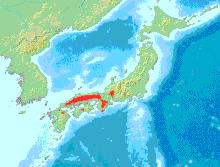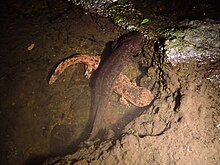| Japanese giant salamander | |
|---|---|

| |
| Japanese giant salamander in Tottori Prefecture, Japan | |
| Scientific classification | |
| Domain: | Eukaryota |
| Kingdom: | Animalia |
| Phylum: | Chordata |
| Class: | Amphibia |
| Order: | Urodela |
| Family: | Cryptobranchidae |
| Genus: | Andrias |
| Species: | A. japonicus
|
| Binomial name | |
| Andrias japonicus (Temminck, 1836)
 | |
| Synonyms[2] | |
|
List
| |


The Japanese giant salamander (Andrias japonicus) is a species of fully aquatic giant salamander endemic to Japan, occurring across the western portion of the main island of Honshu, with smaller populations present on Shikoku and in northern Kyushu. With a length of up to 5 feet (1.5 m),[4] it is the third-largest salamander in the world, only being surpassed by the very similar and closely related Chinese giant salamander and the South China giant salamander.
It is known in Japanese as Ōsanshōuo (オオサンショウウオ/大山椒魚), literally meaning "giant salamander". Other local names include Hanzaki[5], Hanzake[6], and Ankou.[5] This salamander was first catalogued by Europeans when the resident physician of Dejima Island in Nagasaki, Philipp Franz von Siebold, captured an individual and shipped it back to Leiden in the Netherlands, in the 1820s. The species was designated as a special natural monument in 1951, and is protected by the Central Government.[7] It is one of the only six species of giant salamanders in the world.
- ^ IUCN SSC Amphibian Specialist Group (2022). "Japanese Giant Salamander". IUCN Red List of Threatened Species. 2022. Retrieved 9 December 2022.
- ^ "Amphibian Species of the World - Andrias japonicus (Temminck, 1836)". Research.amnh.org. Archived from the original on 2009-03-26. Retrieved 2010-02-04.
- ^ "Appendices | CITES". cites.org. Retrieved 2022-01-14.
- ^ Andrias japonicus - Amphibiaweb
- ^ a b "What is the Hanzaki Research Institute of Japan?". 日本ハンザキ研究所 (in Japanese). Retrieved 2021-11-17.
- ^ "ハンザケ資料展示室". よりみちにちなん (in Japanese). 2020-02-29. Retrieved 2021-11-17.
- ^ オオサンショウウオ (in Japanese). The Agency for Cultural Affairs. Retrieved 2011-09-24.
